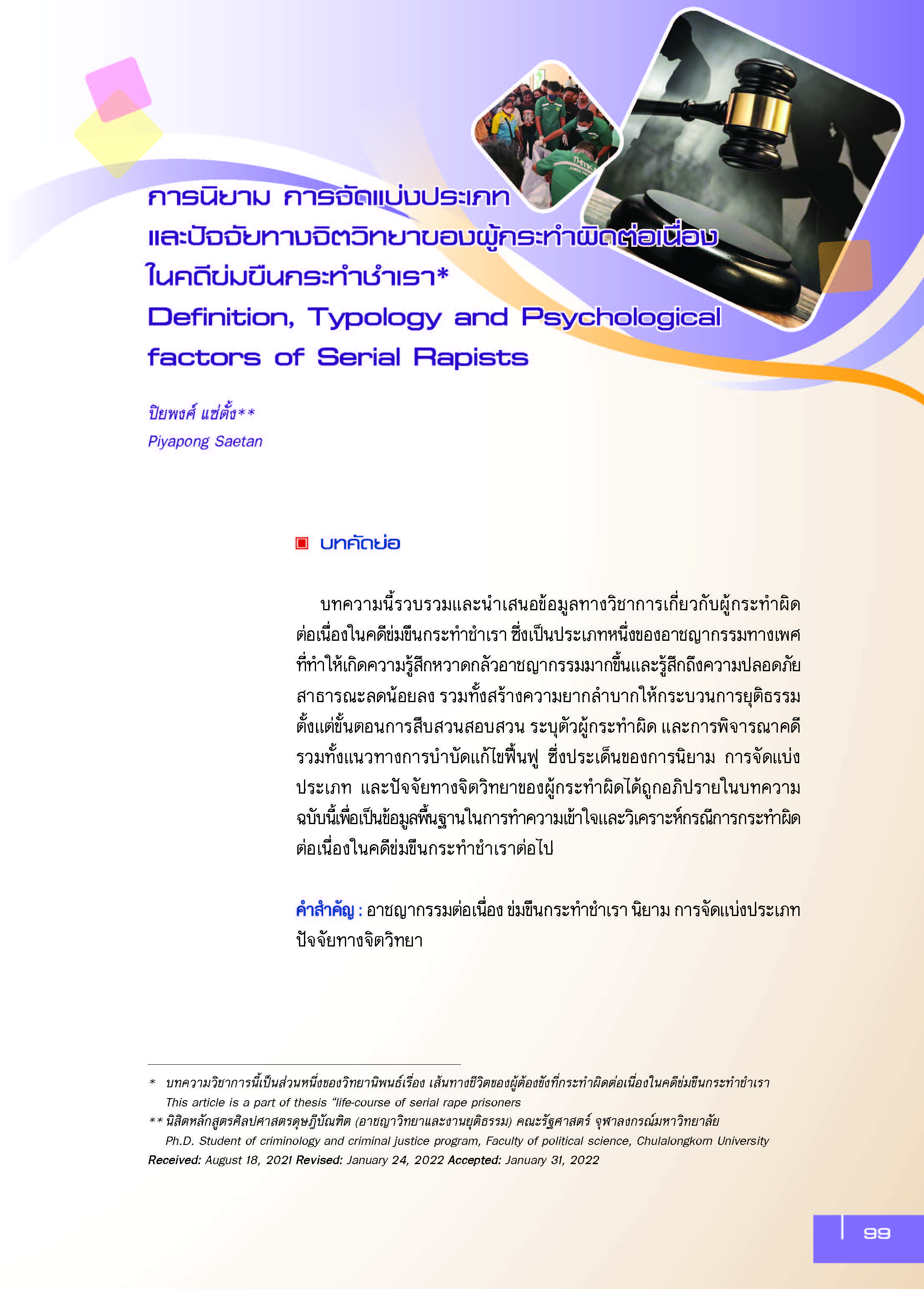Definition, Typology and Psychological factors of Serial Rapists
Main Article Content
Abstract
In this article, academic information on serial rapists in rape case was collected and presented. This is one type of sex crime that creates a greater sense of fear and diminishes a sense of public safety. Besides, serial rapists make the criminal justice process more difficult at the processes of investigation, offender identification, prosecution as well as the rehabilitation guidelines. The issue of definition, typology, and the psychological factors of the offender were discussed in this article. This can be the fundamentals for understanding and analysis in serial rape cases.
Article Details

This work is licensed under a Creative Commons Attribution-NonCommercial-NoDerivatives 4.0 International License.
Published Manuscripts are the copyright of the Journal of the Justice System. However; the opinions that appeared in the content are the sole responsibility of the author.
References
จอมเดช ตรีเมฆ. (2561). Criminology. ปทุมธานี: สำนักพิมพ์มหาวิทยาลัยรังสิต.
ราชบัณฑิตยสถาน. (2556). พจนานุกรมศัพท์จิตวิทยา (พิมพ์ครั้งที่ 2). กรุงเทพฯ: ธนาเพรส.
สำนักงานตำรวจแห่งชาติ. (2563). สถิติคดีอาญา. ค้นเมื่อ 29 พฤษภาคม 2563, จาก http://pitc.police.go.th/dirlist/dirlist.php?dir=/crimes
Borgeson, K., & Kuehnle, K. (2012). Introduction: Why study serial crime? In K. K. Borgeson. (Ed.), Serial offenders: Theory and practice (pp. 1-15). Jones & Bartlett learning.
Gavin, H. (2014). Criminological and forensic psychology. London & Thousand Oaks, CA: Sage.
Howitt, D. (2015). Introduction to forensic and criminal psychology (5 ed.). LA: Pearson.
Jenkins, A., & Petherick, W. (2013). Serial Rape. In W. Petherick (Ed.), Profiling and Serial Crime: Theoretical and Practical Issues (pp. 319-340). Elsevier. https://doi.org/https://doi.org/10.1016/B978-1-4557-3174-9.00015-X
Kocsis, R. N. (2006). Criminal profiling: Principles and practice. NJ: Humana Press.
Miller, L. (2012). Criminal psychology: Nature, nurture, culture : A textbook and practical reference guide for students and working professionals in the fields of law enforcement, criminal justice, mental health, and forensic psychology. Illinois: Charles C Thomas.
Osborne, J. R., & Salfati, C. G. (2015). Re-conceptualizing “cooling-off periods” in serial homicide. Homicide Studies, 19(2), 188-205.
Przybylski, R. (2015). Recidivism of adult sexual offenders. Sex Offender Management Assessment and Planning Initiative: Research Brief.
Scurich, N., & John, R. S. (2019). The dark figure of sexual recidivism. Behavioral Sciences & the Law, 37(2), 158-175.
Shipley, S. L., & Arrigo, B. A. (2008). Serial killers and serial rapists: Preliminary comparison of violence typologies. In R. N. Kocsis (Ed.), Serial murder and the psychology of violent crimes. NJ: Humana Press.
Trzaskawka, P. (2019). Rape-related Terminology in Japanese and its Translation into English and Polish. Studies in Logic, Grammar and Rhetoric, 58(1), 195-209.
World Health Organization. (2003). Guidelines for medico-legal care of victims of sexual violence. Retrieved 29 May, 2020 from https://apps.who.int/iris/bitstream/handle/10665/42788/924154628X.pdf?sequence=1&isAllowed=y


